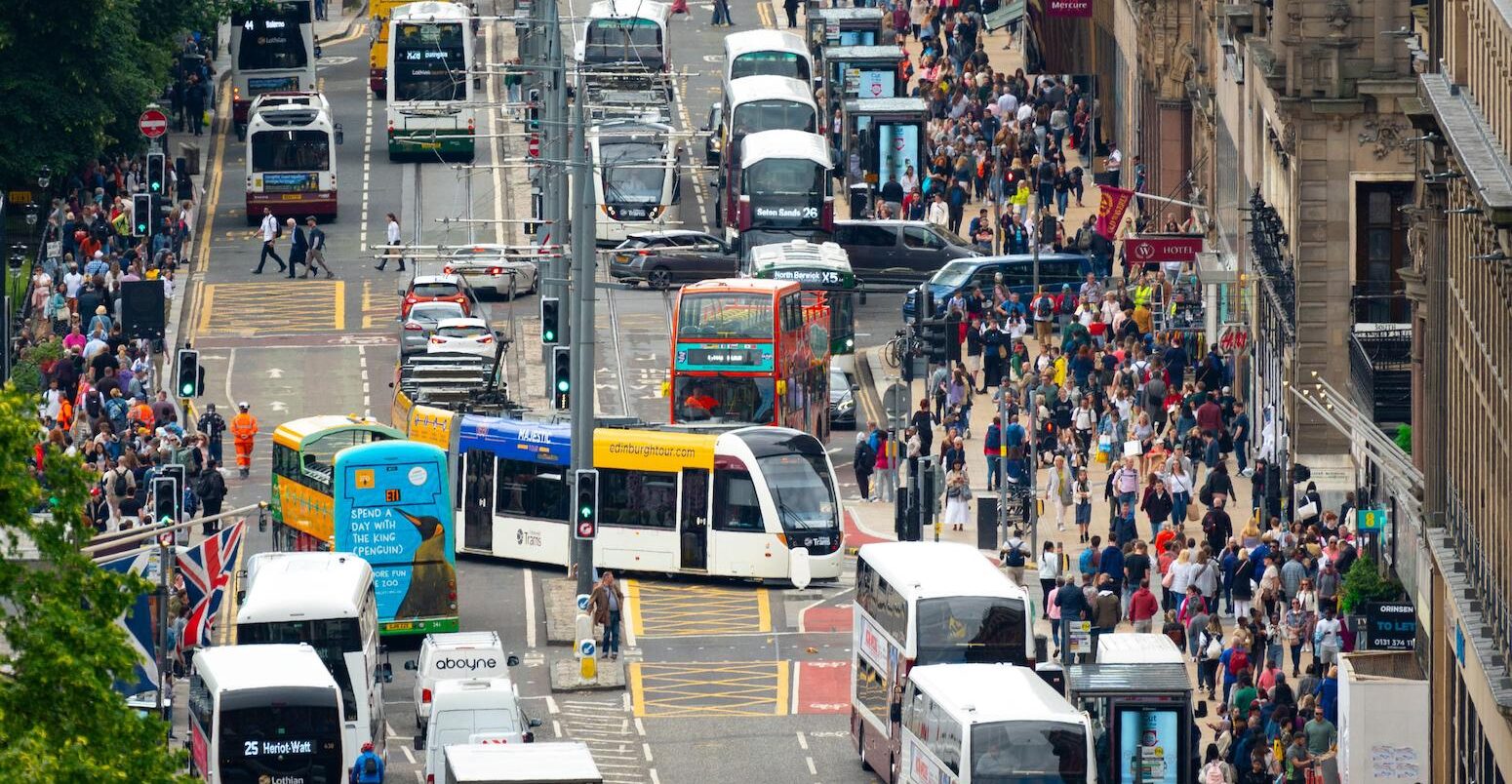
Guest post: How 120 of the world’s major cities could cut transport CO2 by 22%
Multiple Authors
11.06.23Multiple Authors
06.11.2023 | 8:00amCities are often overlooked as being a major contributor to climate change. Yet their diversity has made it hard to assess how far they can cut their emissions.
Moreover, efforts to tackle their emissions, such as those from urban transport, often come with trade-offs in terms of costs and co-benefits from cleaner air or health.
In our new study, published in Nature Sustainability, we conducted a comprehensive analysis of transport policies in 120 cities, spanning five continents.
We found that the cities could cut carbon dioxide (CO2) emissions by a combined 22%, without cutting residents’ quality of life measured via an aggregate, monetised metric.
In individual cities, we found that a combination of policies, such as fuel taxes, public transport improvement and urban planning, could reduce transport CO2 by 30% or more.
Cities in climate policies
Cities bear a major responsibility for climate change, as they account for 70% of global emissions.
They can also play a key role in implementing climate action at the local level. Many cities have set ambitious climate goals, with members of the Global Covenant of Mayors city network, for instance, aiming to reduce their emissions by 66% by 2050.
Urban transport, in particular, is an important sector, representing 8% of global emissions alone. This also tends to be an area where cities have the ability to act.
Yet, quantifying the aggregated potential of cities to mitigate transport emissions has proven challenging. Indeed, the impacts of city-level policies depend on the unique characteristics of each city, such as urban spatial organisation and existing infrastructure.
On the other hand, detailed city models applied to case-study cities are difficult to generalise, since the scientific literature is fragmented and biased toward larger cities and developed countries.
Exploring strategies
Using an urban simulation model, we estimated the aggregate potential for 120 cities on five different continents to reduce their urban transport emissions.
We also considered the impact of such climate actions on inhabitants’ quality of life, through housing and transport prices, local taxes and health co-benefits related to transportation. This included those related to cleaner air, reduced noise, reduced traffic accidents and increased physical activity due to active transportation modes.
The 120 cities are home to 525 million inhabitants, or about 20% of the total global population that lives in cities larger than 300,000 people.
To calibrate the model on each city, we relied on spatially explicit socio-economic data that we collected through web-scraping of local websites, as well as data on local transportation systems that was provided by Open Street Map, Google Maps and Baidu Maps.
Our study explores four main types of complementary strategies that could help reduce transport-related emissions in cities: taxation of polluting vehicles; incentives to use vehicles that consume less fossil fuel; investment in public transport; and urban planning policies that restrict urban sprawl.
For each of these strategies, we examined examples of public policies that can be implemented at local level. For example, to improve public transport, one possibility is to set up a bus rapid transit system on dedicated lanes.
Other examples include that urban planning can involve limiting new construction away from public transport stations. Polluting vehicles can be taxed by raising fuel prices or by introducing local congestion charges.
Finally, the use of more efficient vehicles, such as electric cars, can be encouraged by a combination of subsidies and bans on the most polluting vehicles in urban centres.
Comparing local policies
Our findings suggest that a combination of these policies could reduce overall transportation GHG emissions by up to 31% in 15 years, across the 120 cities studied.
Policies implemented individually could mitigate emissions by 4% to 12%, depending on the policy considered.
These results are in line with the scientific and “grey” literature on the topic, which has shown that urban transport emissions could be mitigated by 20% to 25% through a combination of urban planning and technological solutions.
The impact of a given policy varies according to the city in which it is implemented. For example, in the majority of South American cities studied, the introduction of new public transport lines would be particularly beneficial, our results suggest.
Given the relatively high population density and underdeveloped public transport systems in these cities, our simulations indicate that the implementation of new public transport lines could potentially reduce emissions by up to 21% and 26% in Brazilian cities such as Goiânia and Belém, respectively.
In Europe, taxing fuel prices appears to be more effective, primarily due to the generally well-developed public transport networks available in European cities. For instance, a fuel tax would lead to a 7.5% reduction in transport-related emissions in Barcelona, we found, while the impact would be only 0.6% in Atlanta (USA), where alternatives to private cars are less readily accessible.
Simultaneous implementation of multiple policies can have a particularly significant impact, our results show. Combining taxes on polluting vehicles with public transport development could result in substantial emission reductions, as could promoting public transport alongside measures to control urban sprawl and increase population density near railway stations.
For instance, in Lille (France), implementing policies to control urban sprawl, tax polluting vehicles and develop public transport concurrently would potentially reduce transport-related emissions by almost 24%, compared to reductions of 9%, 4%, and 7%, respectively, if each policy was implemented individually.
An example of the differing impact of public transport development on CO2 emissions after 15 years can be seen in the map below, with purple circles showing cities that could achieve a more than 10% saving, blue showing 5-10%, green 1-5% and yellow less than 1%.
Variation in transport-related CO2 emissions

Inhabitants’ quality of life
Assuming that these policies are fully financed locally by a tax, our study also estimates their impact on the material conditions of residents and on their health.
We analysed the impacts of urban transport emission reduction policies on a range of factors linked to quality of life. In terms of income, for example, building locally financed public transit lines increases local taxes, while taxing polluting vehicles reduces them. We also looked at transportation costs, average housing prices, air quality, noise pollution, road accidents and the health benefits associated with “active” mobility (walking or cycling instead of driving).
Depending on the city, these impacts can be positive or negative overall. A fuel tax or the opening of new public transport lines would be expected to improve air quality, reduce noise pollution and the number of road accidents. More efficient vehicles improve air quality and reduce the household transport budget – even if their impact in terms of road accidents remains unchanged.
On the other hand, urban planning that limits urban sprawl can contribute to higher housing prices and the introduction of public transport lines can sometimes prove extremely costly.
To facilitate comparison, we expressed these variations in monetary terms, creating a composite indicator of welfare that encompasses all dimensions of residents’ quality of life mentioned earlier, as shown in the figure below.
Our study reveals that, in all cities examined, there are policy combinations that can effectively reduce emissions while improving overall well-being.

Most importantly, if, in each of the 120 cities of our sample, instead of applying all the policies that we considered, we choose to apply only policy combinations which do not reduce our monetised measure of welfare, we find that we can reach in total a 22% reduction in urban transportation GHG emissions in 15 years.
This means that most of the emission reductions that we simulate in our study can be reached without affecting residents’ quality of life in any of the cities that we considered.
While 22% is not sufficient, in itself, to reach carbon neutrality, we only analysed four simple and generic policies. Specifically designed and optimised policy portfolios for each city could reach larger emission reductions.
Climate governance and research
As numerous protests worldwide have demonstrated, public policies aimed at reducing emissions must also positively impact residents’ quality of life to gain acceptance.
In all the cities that we studied, we found that it is possible to combine reduction of GHG emissions and the enhancement of quality of life, through well-adapted policy choices.
In order to achieve this, the set of policies needs to be tailored to each city’s specificities, however, with strategies which cannot necessarily be directly transposed from one city to another. In our city sample, the emission reduction that can be reached – even with a generic policy toolkit – is also significant.
Cities are frequently overlooked in international climate discussions, in part because of the diversity of their characteristics. This diversity does make it difficult to assess the potential of urban policies to contribute to global climate goals.
With the recent increases in local urban data becoming available, however, our study shows that it is now possible to explicitly model and assess the consequences of climate strategies over a wide range of cities.
Important research gaps still remain. We could not, for instance, include any African cities in our sample due to challenges accessing reliable and comparable data. If current trends in data availability continue, this and other issues could be solved over the coming years.
Liotta, C., Viguié, V., Creutzig, F. (2023) Environmental and welfare gains via urban transport policy portfolios across 120 cities, Nat Sustain. https://doi.org/10.1038/s41893-023-01138-0
-
Guest post: How 120 of the world’s major cities could cut transport CO2 by 22%




